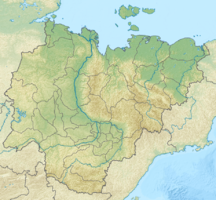Ust-Lenski-Sapowednik
|
Sapovednik Ust-Lenski
|
||
|
Reindeer in Sapowednik (2014) |
||
| location | Bulunski ulus , Sakha (Yakutia) , Russia | |
| surface | 14,330 km² | |
| WDPA ID | 11832 | |
| Geographical location | 73 ° 11 ' N , 125 ° 19' E | |
|
|
||
| Sea level | from 0 m to 560 m | |
| Setup date | 18th December 1985 | |
| administration | Ministry of Natural Resources and Environment | |
The Ust-Lenski-Sapowednik ( Russian Усть-Ленский государственный природный заповедник ) is a nature reserve in Bulunski ulus of the Sakha Republic in Russia . It was founded on the decision of the Council of Ministers of the Russian Federal Socialist Soviet Republic on December 18, 1985. The nature reserve comprises two separate areas in the Lena Delta . The primary protection goal is the preservation and research of the ecosystem .
description
The Lena Delta is the largest river delta in the Arctic with an area of around 32,000 km² . It consists of thousands of islands, lakes, and river branches. The permafrost here extends to a depth of 500 to 600 m. The thawing floor is 30 to 50 cm thick during the short summer. During this time, the frozen tundra is transformed into a fertile wetland , which is particularly suitable for waterfowl .
The sapovednik consists of two separate areas that are clearly different from each other. The larger part, called "Delta" and an area of 13,300 km², is the northern part of the Lena Delta including the Dunai Archipelago in the Laptev Sea . The 1330 km² smaller part "Sokol" (German: falcon) includes the up to 560 m high northern foothills of the Verkhoyansk Mountains , which are flowed around in the west by the Lena, in the north and east by its Bykowskaja Protoka estuary . The reserve is surrounded by a 10,500 km² buffer zone.
The Ust-Lenski-Sapovednik is part of the regional Lena Delta Reserve , which has the status of a resource reserve (ресурсный резерват) and includes the entire Lena Delta, the New Siberian and other islands.
flora
The dominant type of vegetation in Sapowednik is the tundra , which is often characterized by ice wedge polygons that form a network-like pattern. Regularly shaped ponds, in which hydrophytes such as various types of sedges and mosses thrive, are separated from one another by raised edges that are covered with dwarf shrubs and mosses. About 42% of the reserve is occupied by freshwater habitats, another 12% by swamps, and 5% is devoid of vegetation.
Circumpolar species mix with East Siberian species in the reserve. A total of 402 kinds of come angiosperms , 237 lichen species , 115 species of moss, a type of lycopodiopsida and four kinds of ferns before. At gymnosperms only is Larch present, forms the smaller south of the "Sokol" forests. 24 plant species are considered endangered. Among them are the fleabane Erigeron komarovii , the dandelion lenaense Taraxacum , the poppy Papaver czekanowskii , the cinquefoil Potentilla pulchella and the Golden root ( Rhodiola rosea ). The bluegrass Poa trautvetteri is endemic to the area.
fauna
Mammals
The severe climate allows only a few larger animals to live in sapovednik all year round. These include the polar bear , the arctic fox , the mountain hare , the Nordic vole , the Siberian lemming and the real collar lemming . In summer, herds of reindeer move into the delta, followed by wolves . Snow sheep , black hat marmots and northern pika live in the mountains to the south of the reserve . Belugas , narwhals , walruses , ringed seals and bearded seals can be found in the mouths of the Lenaarme . A total of 33 species of mammals can be found in the sapovednik.
Birds
109 bird species populate the nature reserve, 60 of them nest here. Bean geese arrive as early as late May, soon followed by gray-fronted geese and brent geese . Red-throated and black-throated divers breed on the tundra, while the breeding colonies of the rose and swallow gulls are right by the sea. Also Krick- , spit , checks and long-tailed ducks and King Eider breed in Sapowednik. The few birds that overwinter in the delta include snowy owls, as well as ptarmigan and ptarmigan . Of birds of prey we find the gyrfalcon , the Merlin and Peregrine . Of the 27 songbird species represented , 17 nest in the reserve. The most common are the snow bunting and the spur bunting .
Some of the birds found in the reserve, such as the little goose , the red-necked goose and the barnacle crane, are on the Red List of Endangered Species published by the International Union for Conservation of Nature and Natural Resources (IUCN) .
fishes
36 species of fish are known in the Lena Delta . The arctic lamprey , arctic char , burbot , white salmon and arctic whitefish spawn here. Coregonus species such as the Lena tugun , the muksun and the peled vendace often live in the transition area from fresh to salt water. Furthermore, the Siberian sturgeon , the Taimen , the Lenok , the Arctic grayling and the roach were found in the delta.
Web links
- Official website of the Sapovednik (Russian)
- The Sapovednik Ust-Lenski on the website "Wild Russia" (English)
- The Sapovednik Ust-Lenski on the website "Protected Areas of Russia" (Russian)
- The Sapowednik Ust-Lenski at the Russian Ministry of Natural Resources and Environment (Russian)
- Map of the Ust-Lenski-Sapowednik

